Key takeaways:
- Legacy code often lacks documentation, making it challenging to navigate and understand, emphasizing the need for clear documentation.
- Refactoring improves code health, scalability, and team collaboration, leading to cleaner, more manageable codebases.
- A proactive maintenance strategy and the integration of automation and modern technologies are crucial for the sustainability of legacy systems.
- Effective communication and documentation during the refactoring process are essential to avoid pitfalls and enhance team collaboration.
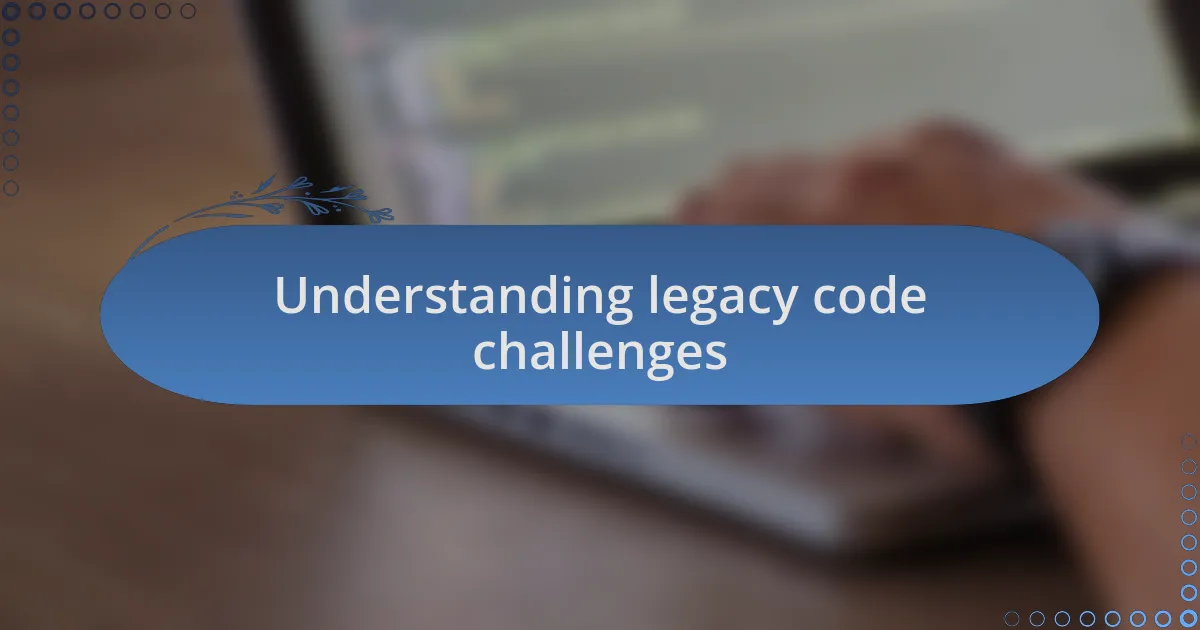
Understanding legacy code challenges
Legacy code can feel like a time capsule, preserving the past decisions and practices of developers who came before us. I remember diving into a project where the original code was like a foreign language to me, full of outdated patterns and inconsistent naming conventions. Have you ever felt lost trying to navigate through a maze created by someone else’s logic?
One of the biggest challenges is the fear of breaking something when you touch legacy code. I recall spending hours meticulously documenting everything before I made even the smallest change, anxiety about what a ripple effect could occur. It’s a tough spot—do we prioritize innovation and features, or is maintaining stability the golden rule here?
I also found that often, legacy code has little to no documentation. It’s like trying to read a book with half the pages missing! I’ve faced moments where a simple function needed hours of investigation to understand its role. These experiences taught me the value of clear documentation and the need to be patient as we figure out the right path forward.
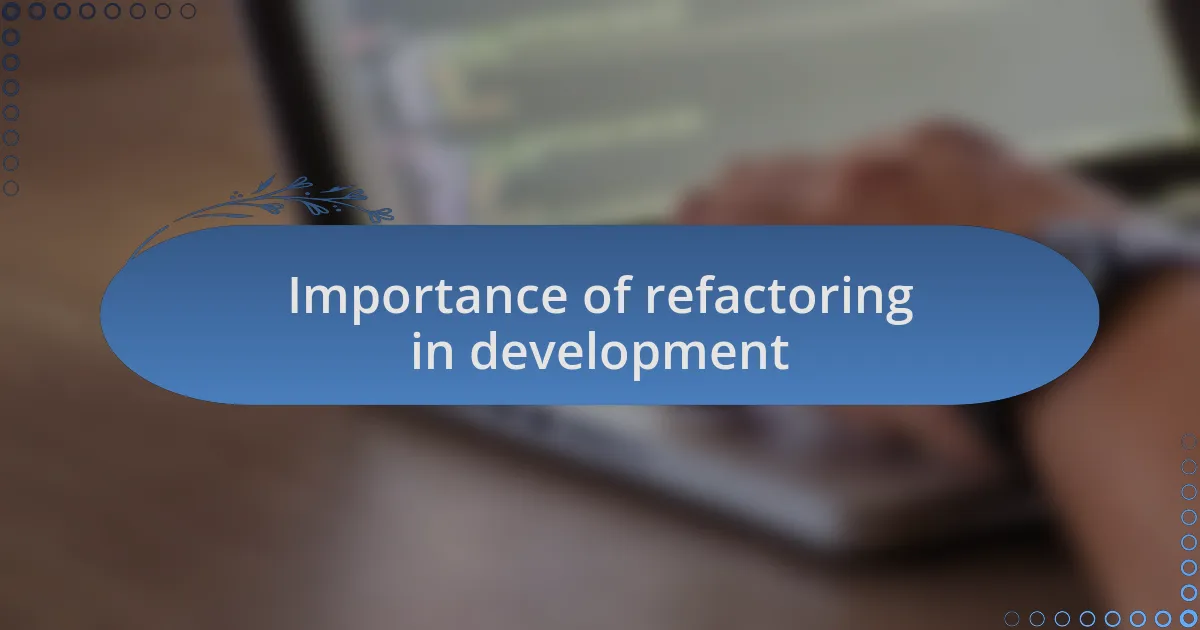
Importance of refactoring in development
Refactoring is crucial in development because it acts as a health check for the codebase. I vividly remember a project where we faced constant bugs; it was like fighting fires daily. Once we took the time to refactor key components, the code became cleaner and more manageable, leading to fewer headaches for the entire team.
When I think about the importance of refactoring, I often reflect on how it promotes scalability. For instance, I worked on an application that needed to grow rapidly due to increased user demand. Through refactoring, we modularized the code, making it adaptable for future features without the fear of colliding with existing functionalities. Isn’t it reassuring when you know your code can evolve with your project?
Additionally, refactoring enhances collaboration among developers. I recall a situation where new team members struggled to understand existing code. After a refactor, they could contribute more effectively, as the clearer structure made it easier for them to grasp the logic. How much more productive do you think a team can be when everyone is on the same page?
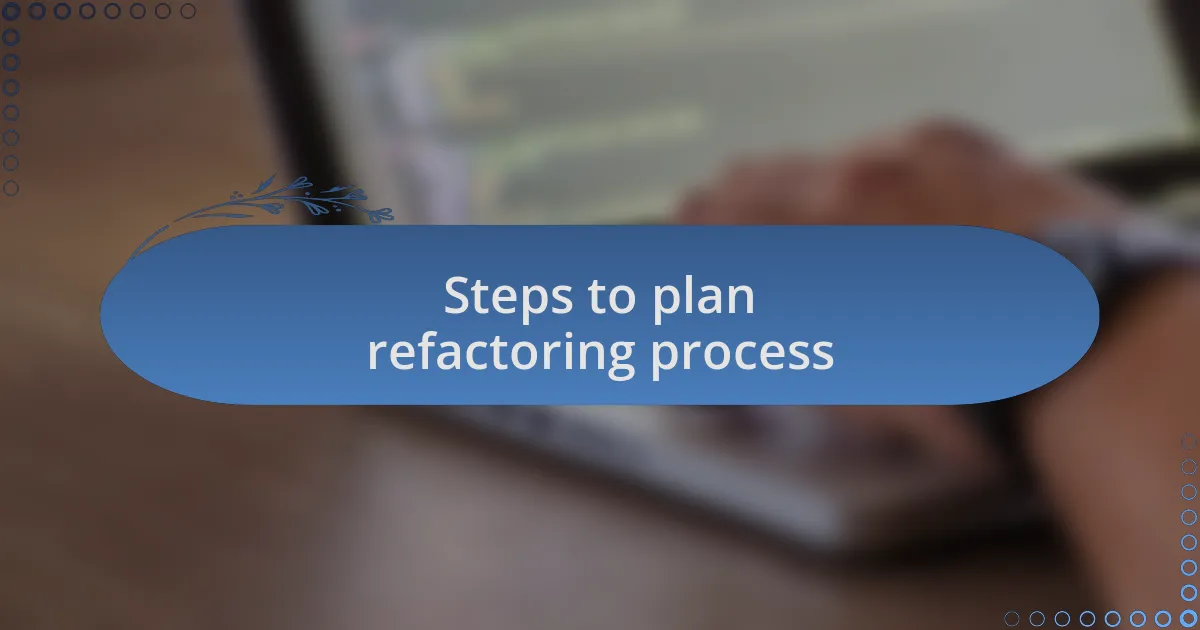
Steps to plan refactoring process
When planning a refactoring process, I always begin with a thorough assessment of the current codebase. In one experience, we conducted a code review that revealed several areas needing improvement. This evaluation helped us prioritize which sections required urgent attention and which could be addressed later—an organized approach is crucial to avoid getting overwhelmed.
Next, I advocate for involving the entire development team in the planning stage. There’s something about brainstorming together that sparks creativity and builds a stronger sense of ownership. In a previous project, I noticed that team members often held valuable insights about the code’s quirks. By discussing these points, we created a more comprehensive plan that everyone was aligned with. Don’t you find it empowering when every voice contributes to the vision?
Lastly, it’s essential to define clear goals for the refactoring effort. In my experience, I once set a goal to reduce loading times by 30% through refactoring. This focus helped guide our decisions and kept us motivated, as we could measure our progress against that target. How satisfying is it to see your efforts yield tangible results that enhance user experience?
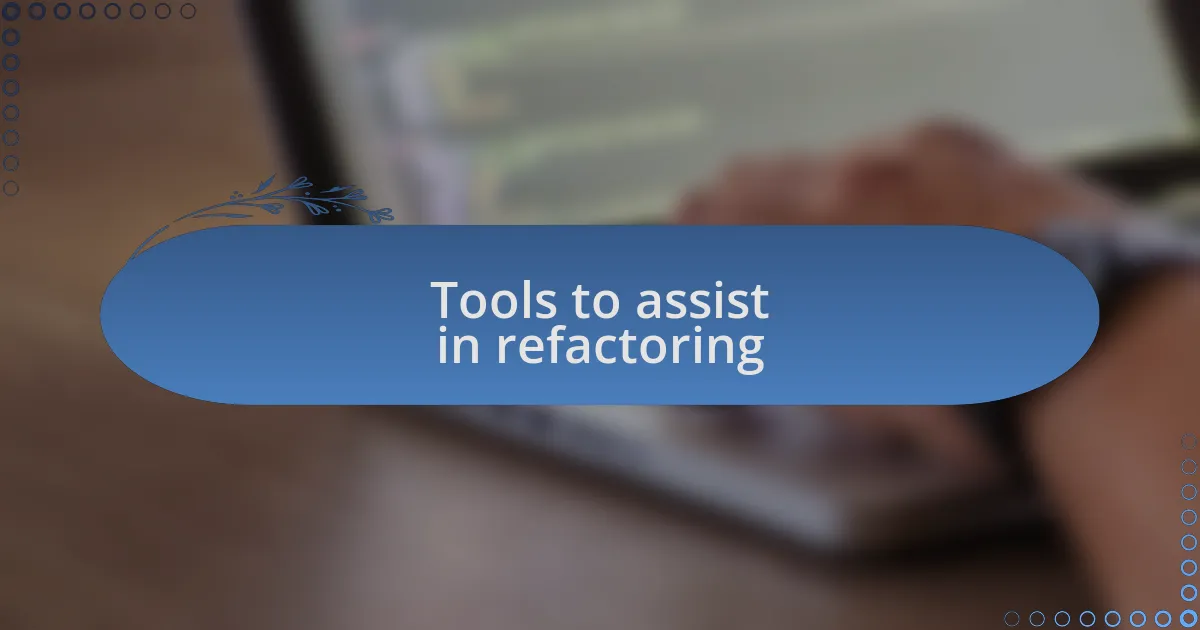
Tools to assist in refactoring
When it comes to refactoring, having the right tools is essential. I personally rely on Integrated Development Environments (IDEs) like Visual Studio Code and IntelliJ IDEA, which offer built-in refactoring capabilities that can streamline the entire process. I remember using these tools during a particularly challenging refactor where their intelligent suggestions made navigating complex dependencies much more manageable. Have you ever wished a tool could predict your next move? That’s exactly what these IDEs can do.
Static analysis tools, such as SonarQube or ESLint, are also invaluable in a refactoring effort. They help identify code smells, vulnerabilities, and areas for improvement in real-time. During one project, running SonarQube uncovered critical issues that we hadn’t noticed before, proving it is not just about changing code but ensuring that what we have is solid. If you’ve ever felt the frustration of missing a simple bug, you know how crucial this oversight can be.
Lastly, version control systems like Git play a pivotal role in refactoring. They allow you to track changes, enabling easy backtracking if something goes awry. I’ve had moments when I confidently pushed a new feature only to discover it broke something else. Being able to revert changes quickly was a lifesaver. Isn’t it a relief knowing you have a safety net while navigating the sometimes perilous waters of changing legacy code?
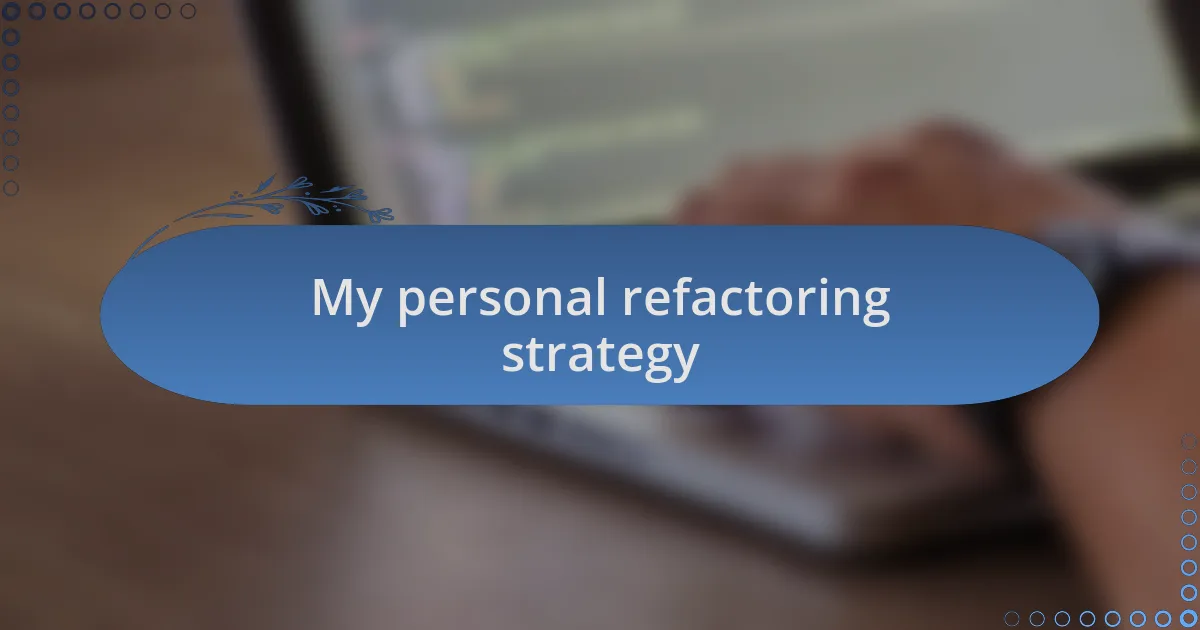
My personal refactoring strategy
My personal approach to refactoring starts with understanding the legacy code intimately. I like to run through the existing functionality while adding unit tests, almost like retracing my steps in a familiar but dimly lit room. I recall a time when I dedicated hours to this process, and it was enlightening—slowly, patterns emerged, and with each test I wrote, I felt a sense of clarity washing over me.
After mapping out the functionality, I prioritize the areas that need the most attention, both in terms of risk and potential impact. I often ask myself, “Which parts of this code are most likely to cause problems later?” I once faced a particularly tangled part of an application and decided to tackle it first. The relief I felt after isolating the issues and refactoring that section was immense; I could finally breathe easier knowing I had reduced the technical debt substantially.
Next, I break down the refactoring tasks into manageable chunks, focusing on one piece at a time. It’s like assembling a puzzle; I work on fitting together the pieces, and the satisfaction grows as the picture becomes clearer. When I completed a project that involved gradual refactoring, I felt a rush of accomplishment seeing the code evolve into something more maintainable and elegant. Isn’t it gratifying to turn chaos into order and know you’re building something sustainable for the future?

Lessons learned from refactoring
Throughout my journey of refactoring, I’ve learned that communication is key. In one memorable project, I decided to involve the entire team in discussions about the changes I was implementing. This not only led to invaluable feedback but also created a sense of ownership among the developers. It struck me how collaborative efforts can often reveal insights I might have overlooked on my own.
Additionally, I’ve come to embrace patience as an essential virtue in refactoring. There was a phase in my career when I underestimated the complexity of intertwining features. I remember feeling frustrated during a particularly drawn-out refactor that seemed to amplify every issue. However, that experience taught me that taking a step back often leads to clearer insights and solutions that unveil themselves with time. Have you ever found that the best ideas surface when you allow yourself a little breathing room?
I also realized the importance of documenting the refactoring process itself. Early on, I would dive in without taking proper notes, thinking I could remember everything. But after spending endless hours retracing my steps during a complicated revision, I learned the hard way. Now, I make it a habit to document not just what I changed but why I made those choices; it has become a crucial part of my workflow, helping both me and my team avoid the same pitfalls in future iterations. Wouldn’t you agree that having a clear trail makes navigating legacy code a lot less daunting?
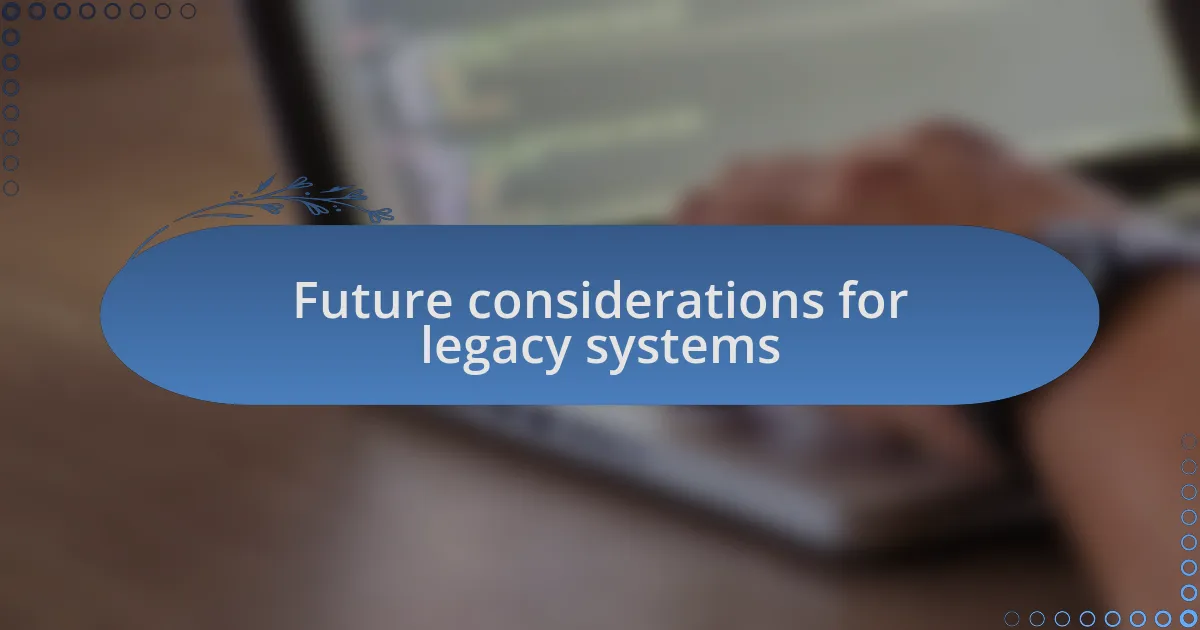
Future considerations for legacy systems
Future considerations for legacy systems should include a proactive approach to ongoing maintenance and upgrades. I recall a project where we focused on consistently allocating time for refactoring, even in the midst of new features being developed. This decision ultimately minimized technical debt and ensured the legacy system stayed relevant and manageable, creating a smoother workflow for everyone involved. Have you noticed how regular attention can help avert a crisis later?
Another aspect to consider is the possibility of introducing automation in testing and deployment processes. In one of my experiences, I implemented automated tests for an older codebase, which transformed the way we handled deployments. I vividly remember the sigh of relief that swept through the team as we watched the once tedious process become streamlined, allowing us to focus on improvements rather than firefighting. Isn’t it fascinating how automation can breathe new life into aging systems?
Finally, exploring modern technologies or frameworks could provide a pathway to a more sustainable legacy system. I’ve seen teams thrive after transitioning parts of their legacy code to a new framework, thus enhancing performance and maintainability. However, it requires careful planning and buy-in from all stakeholders. Have you ever felt the thrill of watching a legacy system evolve into something new and efficient? It’s a reminder that the future of legacy systems doesn’t have to be a dead end; instead, it can be a launching pad for innovation.